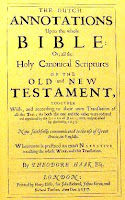
A few days ago one of my favorite bloggers, PeaceBang, wrote a short note about someone she had seen at the
Festival of Homiletics in Nashville last week:
[I just want to ] send a short note to the young male clergydude who was wearing a tie-dye teeshirt in the most garish shades of orange and blue, shorts and bright orange Crocs:
Sweetheart, Jesus wants you for a sunbeam, not an acid trip.

This brings me to a recent book by Russell Smith,
Men’s Style: The Thinking Man’s Guide to Dress (Thomas Dunne, 2007). It's not the usual candidate for a mention among the top fifty theology reference books of the year. But the clergy person does have to dress, and ought to think hard about clothes and their appropriateness for the situation. This is about "contextualization," folks. Whether you like it or not, what you wear, when you wear it, and how you wear it communicates something. In January of 2005 when VP Dick Cheney wore a fur-hooded parka, snow boots, and a wool toque to the somber ceremony commemorating the 60th anniversary of the liberation of Auschwitz, he communicated something. All the European dignitaries present wore formal, dark woolen overcoats and clothing more fitting for the occasion. For clergy, if you're Roman Catholic or Orthodox, many of those decisions are already prescribed for you. But we Protestant clergy have choices to make.

Smith is a little too formal for my own taste, but his book is well-informed, witty, entertaining and very readable. While it's not directed to clergy, you can do some of your own travelling here. In some situations, in some congregations, it might be perfectly appropriate to conduct a winter graveside service in brightly colored Gore-Tex. But you might at least read Smith to know your alternatives. What does it mean when the invitation says "Black Tie" or "Black Tie Optional"? What options do you have for shirts, suits, shoes and facial hair? What sort of connotations does a bow-tie have? There are other books out there about dress, but if your public library has Smith, check it out.

I know -- what about female clergy? Back to PeaceBang's blog --
Beauty Tips for Ministers , subtitled: "Because you're in the public eye, and God knows you've got to look good." PeaceBang (pseudonym for a young female Unitarian/Universalist minister) shares her observations about clothing trends and grooming for female and male clergy. See a
recent article about her in Calvin Seminary's student publication,
Kerux. Her
observations on the recent Festival of Homiletics in Nashville, for example, cover matters of great weight, facial hair, men's hair styles, women's footwear, and dirty knapsacks.
I'm a librarian, so I can't help but give a few historical resources about clergy clothing:
- Graeme Murdock, "Dressed to Repress?: Protestant Clerical Dress and the Regulation of Morality in Early Modern Europe," Fashion Theory 4, no. 2 (2000):179-200. Get this through the database Wilson Select Plus (through Hekman Library; search for it by typing in 3 or 4 keywords from the title). This article considers how Reformed and Protestant Churches across Europe dealt with issues of appropriate dress for clergy (and clergy families).
- Reimar Zeller, Prediger des Evangeliums: Erben der Reformation im Spiegel der Kunst (Regensburg: Schnell & Steiner, 1998) HL N8180 .Z45 1998
(I know it's German, but you're looking at the illustrations.) A collection of portrayals of Protestant preachers in art up to the mid-20th century.
- Dress: Sources for Clerical Costume -- Lambeth Palace Library's guide to sources for the costume of both pre-Reformation English clergy and post-Reformation Anglican clergy.
 And finally, to put this all in perspective, a good word from John Chrysostom (not a bad dresser himself) from his sermon Judge not, that you be not judged
And finally, to put this all in perspective, a good word from John Chrysostom (not a bad dresser himself) from his sermon Judge not, that you be not judged
". . .such rich attire is like a pile of withering hay. Beautiful garments are good for worms and moths. When they set upon such a man, they will strip him bare . . . But he who is clothed in virtue cannot be harmed by worms nor even by death itself."

 To get a movie video, most people use one of two options: 1) Go find it and bring it home (a lá Blockbuster) or 2) Have it sent to you (a lá Netflix). To read an academic journal nowadays, you can use the Blockbuster method (find the journal electronically or go physically to the library and get it) or the Netflix method (have it sent to you, either physically by mail or electronically).
To get a movie video, most people use one of two options: 1) Go find it and bring it home (a lá Blockbuster) or 2) Have it sent to you (a lá Netflix). To read an academic journal nowadays, you can use the Blockbuster method (find the journal electronically or go physically to the library and get it) or the Netflix method (have it sent to you, either physically by mail or electronically).






















 A few days ago one of my favorite bloggers, PeaceBang, wrote a short note about someone she had seen at the
A few days ago one of my favorite bloggers, PeaceBang, wrote a short note about someone she had seen at the 























